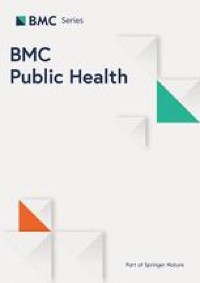Associations among political voting preference, high-risk health status, and preventative behaviors for COVID-19

Antos A, Kwong ML, Balmorez T, Villanueva A, Murakami S. Unusually high risks of COVID-19 mortality with age-related comorbidities: an adjusted Meta-analysis method to improve the risk assessment of mortality using the comorbid mortality data. Infect Dis Rep. 2021;13(3):700–11.
Jordan RE, Adab P, Cheng KK. Covid-19: risk factors for severe disease and death: British Medical Journal Publishing Group; London (UK) 2020.
Team CC-R, Team CC-R, Team CC-R, Chow N, Fleming-Dutra K, Gierke R, et al. Preliminary estimates of the prevalence of selected underlying health conditions among patients with coronavirus disease 2019—United States, February 12–march 28, 2020. Morb Mortal Wkly Rep. 2020;69(13):382–6.
Centers for Disease Control and Prevention (CDC). COVID-19 Vaccination Rollout Reccomendations. COVID-19. Vaccines. [cited 2021 February 3]. Available from: https://www.cdc.gov/coronavirus/2019-ncov/vaccines/recommendations.html.
DeRoo SS, Pudalov NJ, Fu LY. Planning for a COVID-19 vaccination program. JAMA. 2020;323(24):2458-59.
Reiter PL, Pennell ML, Katz ML. Acceptability of a COVID-19 vaccine among adults in the United States: how many people would get vaccinated? Vaccine. 2020;38(42):6500–7.
Daly M, Robinson E. Willingness to vaccinate against COVID-19 in the US: Longitudinal evidence from a nationally representative sample of adults from April-October 2020. medRxiv [Preprint]. 2020. https://doi.org/10.1101/2020.11.27.20239970. Update in: Am J Prev Med. 2021. PMID: 33269354; PMCID: PMC7709168.
Fisher KA, Bloomstone SJ, Walder J, Crawford S, Fouayzi H, Mazor KM. Attitudes toward a potential SARS-CoV-2 vaccine: a survey of US adults. Annals of internal medicine, 2020;173(12):964-973.
Malik AA, McFadden SM, Elharake J, Omer SB. Determinants of COVID-19 vaccine acceptance in the US. EClinicalMedicine. 2020;26:100495.
Loomba S, de Figueiredo A, Piatek SJ, et al. Measuring the impact of COVID-19 vaccine misinformation on vaccination intent in the UK and USA. Nat Hum Behav. 2021;5:337–48. https://doi.org/10.1038/s41562-021-01056-1.
O’Conor R, Opsasnick L, Benavente JY, Russell AM, Wismer G, Eifler M, et al. Knowledge and behaviors of adults with underlying health conditions during the onset of the COVID-19 US outbreak: the Chicago COVID-19 comorbidities survey. J Community Health. 2020;45(6):1149–57.
Wolf MS, Serper M, Opsasnick L, O’Conor RM, Curtis L, Benavente JY, Bailey SC. Awareness, attitudes, and actions related to COVID-19 among adults with chronic conditions at the onset of the US outbreak: a cross-sectional survey. Annals of internal medicine. 2020;173(2):100-109.
Tran V-T, Ravaud P. COVID-19–related perceptions, context and attitudes of adults with chronic conditions: results from a cross-sectional survey nested in the ComPaRe e-cohort. Plos One. 2020;15(8):e0237296.
Williams L, Flowers P, McLeod J, Young D, Rollins L. The CATALYST Project Team. Social Patterning and Stability of Intention to Accept a COVID-19 Vaccine in Scotland: Will Those Most at Risk Accept a Vaccine? Vaccines. 2021;9:17. https://doi.org/10.3390/vaccines9010017.
Sherman SM, Smith LE, Sim J, Amlôt R, Cutts M, Dasch H, Rubin GJ, Sevdalis N. COVID-19 vaccination intention in the UK: results from the COVID-19 vaccination acceptability study (CoVAccS), a nationally representative cross-sectional survey. Hum Vaccin Immunother. 2021;17(6):1612-21. https://doi.org/10.1080/21645515.2020.1846397
Andarge E, Fikadu T, Temesgen R, Shegaze M, Feleke T, Haile F, et al. Intention and practice on personal preventive measures against the COVID-19 pandemic among adults with chronic conditions in southern Ethiopia: a survey using the theory of planned behavior. J Multidiscip Healthc. 2020;13:1863.
McCaffery K, Dodd RH, Cvejic E, Ayre J, Batcup C, Isautier JMJ, et al. Disparities in COVID-19 related knowledge, attitudes, beliefs and behaviours by health literacy. medRxiv. 2020.
Hills S, Eraso Y. Factors associated with non-adherence to social distancing rules during the COVID-19 pandemic: a logistic regression analysis. BMC Public Health. 2021;21(1):352.
Camacho-Rivera M, Islam JY, Vidot DC. Associations between chronic health conditions and COVID-19 preventive behaviors among a nationally representative sample of US adults: an analysis of the COVID impact survey. Health Equity. 2020;4(1):336–44.
Ruiz JB, Bell RA. Predictors of intention to vaccinate against COVID-19: Results of a nationwide survey. Vaccine. 2021;39(7):1080-6.
Gollwitzer A, Martel C, Brady WJ, Pärnamets P, Freedman IG, Knowles ED, Van Bavel JJ. Partisan differences in physical distancing are linked to health outcomes during the COVID-19 pandemic. Nature human behaviour, 2020;4(11):1186-97.
Lightfoot E, Moone RP. Caregiving in times of uncertainty: helping adult children of aging parents find support during the COVID-19 outbreak. J Gerontol Soc Work. 2020;63(6–7):542–52.
Fischer F, Raiber L, Boscher C, Winter MHJ. COVID-19 and the elderly: who cares?. Frontiers in public health. 2020;8:151.
Grossman G, Kim S, Rexer J, Thirumurthy H. Political partisanship influences behavioral responses to governors’ recommendations for COVID-19 prevention in the United States. 2020. Available at SSRN 3578695.
Painter M, Qiu T. Political beliefs affect compliance with covid-19 social distancing orders. 2020. Available at SSRN 3569098.
Tyson A, Johnson C, Funk C. US public now divided over whether to get COVID-19 vaccine. Pew Research Center report 0; 2020.
Grossman G, Kim S, Rexer JM, Thirumurthy H. Political partisanship influences behavioral responses to governors’ recommendations for COVID-19 prevention in the United States. Proc Natl Acad Sci. 2020;117(39):24144–53.
Schake K. Republican politics and policy after trump. Survival. 2020;62(6):35–50.
Barrios JM, Hochberg Y. Risk perception through the lens of politics in the time of the covid-19 pandemic: National Bureau of Economic Research; 2020. Cambridge (USA) Report No.: 0898–2937.
Kushner Gadarian S, Goodman SW, Pepinsky TB. Partisanship, health behavior, and policy attitudes in the early stages of the COVID-19 pandemic. In: Health Behavior, and Policy Attitudes in the Early Stages of the COVID-19 Pandemic (March 27, 2020); 2020.
Andersen M. Early evidence on social distancing in response to COVID-19 in the United States. Available at SSRN 3569368. 2020.
Allcott H, Boxell L, Conway J, Gentzkow M, Thaler M, Yang D. Polarization and public health: partisan differences in social distancing during the coronavirus pandemic. J Public Econ. 2020;191:104254.
Lin C, Tu P, Beitsch LM. Confidence and Receptivity for COVID-19 Vaccines: A Rapid Systematic Review. Vaccines. 2021;9:16. https://doi.org/10.3390/vaccines9010016.
Mesch GS, Schwirian KP. Social and political determinants of vaccine hesitancy: lessons learned from the H1N1 pandemic of 2009-2010. Am J Infect Control. 2015;43(11):1161–5.
Kreps S, Prasad S, Brownstein JS, Hswen Y, Garibaldi BT, Zhang B, et al. Factors associated with US adults’ likelihood of accepting COVID-19 vaccination. JAMA Netw Open. 2020;3(10):e2025594-e.
Romer D, Jamieson KH. Conspiracy theories as barriers to controlling the spread of COVID-19 in t he U.S. Soc Sci Med. 2020;263:113356.
Uscinski JE, Enders AM, Klofstad C, Seelig M, Funchion J, Everett C, et al. Why do people believe COVID-19 conspiracy theories? Harv Kennedy Sch Misinformation Rev. 2020;1(3).
Miller JM. Psychological, political, and situational factors combine to boost COVID-19 conspiracy theory beliefs. Can J Polit Sci/Revue canadienne de science politique. 2020;53(2):327–34.
Pedersen MJ, Favero N. Social distancing during the COVID-19 pandemic: who are the present and future noncompliers? Public Adm Rev. 2020;80(5):805–14.
MacInnis B, Krosnick JA, Ho AS, Cho M-J. The accuracy of measurements with probability and nonprobability survey samples: replication and extension. Public Opin Q. 2018;82(4):707–44.
Yeager DS, Krosnick JA, Chang L, Javitz HS, Levendusky MS, Simpser A, et al. Comparing the accuracy of RDD telephone surveys and internet surveys conducted with probability and non-probability samples. Public Opin Q. 2011;75(4):709–47.
Fahimi M, Kulp D. Address-based sampling may provide alternatives for surveys that require contacts with representative samples of households. Quirk’s Marketing Research Review. https://www quirkscom/articles/address-based-sampling-may-provide-alternatives-for-surveys-that-require-contacts-with-representative-samples-of-households. (Accessed 31 Jan 2018). 2009.
Allen JD, Feng W, Corlin L, Porteny T, Acevedo A, Schildkraut D, et al. Why are some people reluctant to be vaccinated for COVID-19? A cross-sectional survey among US adults in may-June 2020. Prev Med Rep. 2021;24:101494.
Nikolaidis A, Paksarian D, Alexander L, Derosa J, Dunn J, Nielson DM, et al. The coronavirus health and impact survey (CRISIS) reveals reproducible correlates of pandemic-related mood states across the Atlantic. Sci Rep. 2021;11(1):1–13.
Centers for Disease Control and Prevention (CDC). COVID-19. People with Certain Medical Conditions. [cited 2022 February 2] Available from: https://www.cdc.gov/coronavirus/2019-ncov/need-extra-precautions/people-with-medical-conditions.html.
Morgan OW, Bramley A, Fowlkes A, Freedman DS, Taylor TH, Gargiullo P, et al. Morbid obesity as a risk factor for hospitalization and death due to 2009 pandemic influenza a (H1N1) disease. Plos One. 2010;5(3):e9694.
Finderup J, Lomborg K, Jensen JD, Stacey D. Choice of dialysis modality: patients’ experiences and quality of decision after shared decision-making. BMC Nephrol. 2020;21(1):1–12.
Webster RK, Brooks SK, Smith LE, Woodland L, Wessely S, Rubin GJ. How to improve adherence with quarantine: rapid review of the evidence. Public Health. 2020;182:163–9.
Stopka TJ, Feng W, Corlin L, King E, Mistry J, Mansfield W, Wang Y, Levine P, Allen JD. Assessing equity in health, wealth, and civic engagement: a nationally representative survey, United States, 2020. Int J Equity Health. 2022;21(1):12. https://doi.org/10.1186/s12939-021-01609-w.
Raja AS, Niforatos JD, Anaya N, Graterol J, Rodriquez RM. Vaccine hesitancy and reasons for refusing the COVID-19 vaccination among the US public: a cross-sectional survey. medRxiv. 2021. https://doi.org/10.1101/2021.02.28.21252610.
Earnshaw VA, Eaton LA, Kalichman SC, Brousseau NM, Hill EC, Fox AB. COVID-19 conspiracy beliefs, health behaviors, and policy support. Transl Behav Med. 2020;10(4):850–6.
White SJ, Barello S, di San Marco EC, Colombo C, Eeckman E, Gilligan C, et al. Critical observations on and suggested ways forward for healthcare communication during COVID-19: pEACH position paper. Patient Educ Couns. 2021;104(2):217–22.
Porat T, Nyrup R, Calvo RA, Paudyal P, Ford E. Public health and risk communication during COVID-19—enhancing psychological needs to promote sustainable behavior change. Front Public Health. 2020;8:637.
Campos-Mercade P, Meier AN, Schneider FH, Meier S, Pope D, Wengström E. Monetary incentives increase COVID-19 vaccinations. Science. 2021;374(6569):879-82.
Thirumurthy H, Milkman KL, Volpp K, Buttenheim A, Pope DG. Association between statewide financial incentive programs and COVID-19 vaccination rates. Available at SSRN 2021.
Raifman MA, Raifman JR. Disparities in the population at risk of severe illness from COVID-19 by race/ethnicity and income. Am J Prev Med. 2020;59(1):137–9.
Rozenfeld Y, Beam J, Maier H, Haggerson W, Boudreau K, Carlson J, et al. A model of disparities: risk factors associated with COVID-19 infection. Int J Equity Health. 2020;19(1):1–10.
Post RE, Mainous AG, Gregorie SH, Knoll ME, Diaz VA, Saxena SK. The influence of physician acknowledgment of patients’ weight status on patient perceptions of overweight and obesity in the United States. Arch Intern Med. 2011;171(4):316–21.
Lewis S, Thomas SL, Hyde J, Castle D, Blood RW, Komesaroff PA. “I don’t eat a hamburger and large chips every day!” A qualitative study of the impact of public health messages about obesity on obese adults. BMC Public Health. 2010;10(1):1–9.
Salas XR. The ineffectiveness and unintended consequences of the public health war on obesity. Can J Public Health. 2015;106(2):E79.
Grimm P. Social desirability bias. Wiley international encyclopedia of marketing; 2010.
Moore RC, Lee AY, Hancock JT, Halley MC, Linos E. Age-Related Differences in Experiences With Social Distancing at the Onset of the COVID-19 Pandemic: A Computational and Content Analytic Investigation of Natural Language From a Social Media Survey JMIR Hum Factors. 2021;8(2):e26043.
Centers for Disease Control and Prevention (CDC). National Center for Chronic Disease Prevention and Health Promotion (NCCDPHP). Chronic Diseases in America. [cited 2022 February 2] Available from: https://www.cdc.gov/chronicdisease/resources/infographic/chronic-diseases.htm.
Campos-Mercade P, Meier AN, Schneider FH, Wengström E. Prosociality predicts health behaviors during the COVID-19 pandemic. J Public Econ. 2021;195:104367.
Bond KT, Jones K, Ompad DC, Vlahov D. Resources and interest among faith based organizations for influenza vaccination programs. J Immigr Minor Health. 2013;15(4):758–63.
Omer SB, Yildirim I, Forman HP. Herd immunity and implications for SARS-CoV-2 control. JAMA. 2020;324(20):2095–6.

